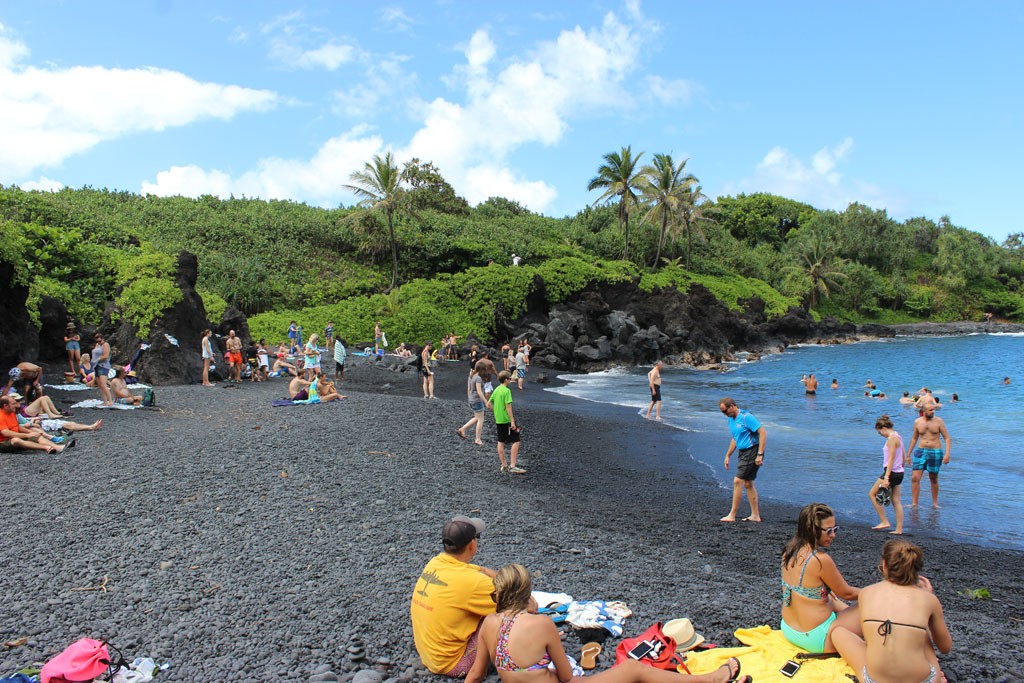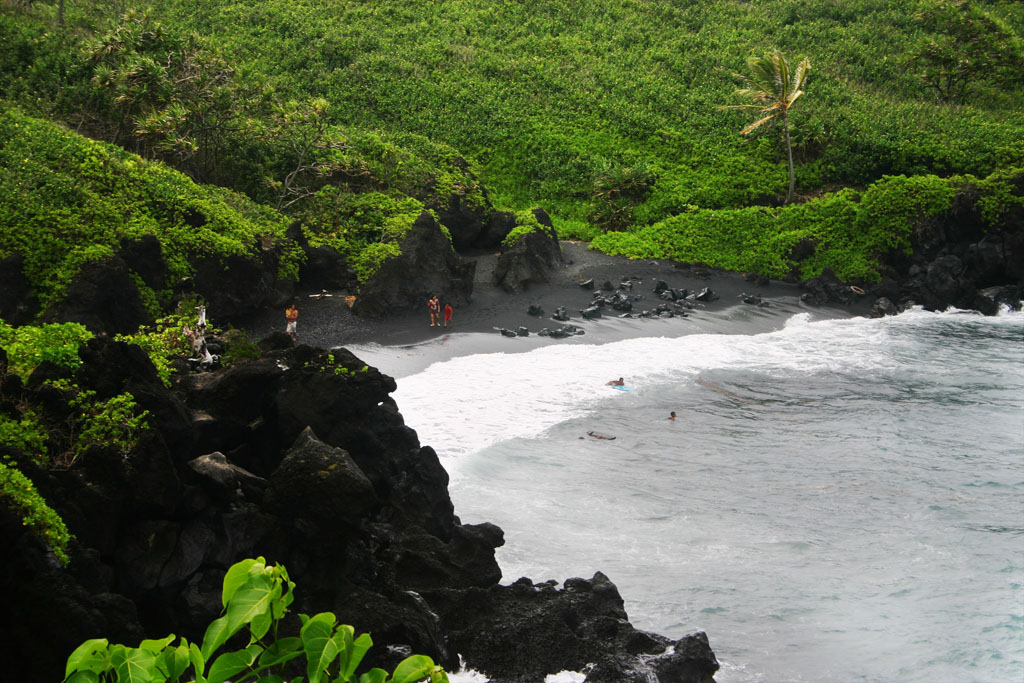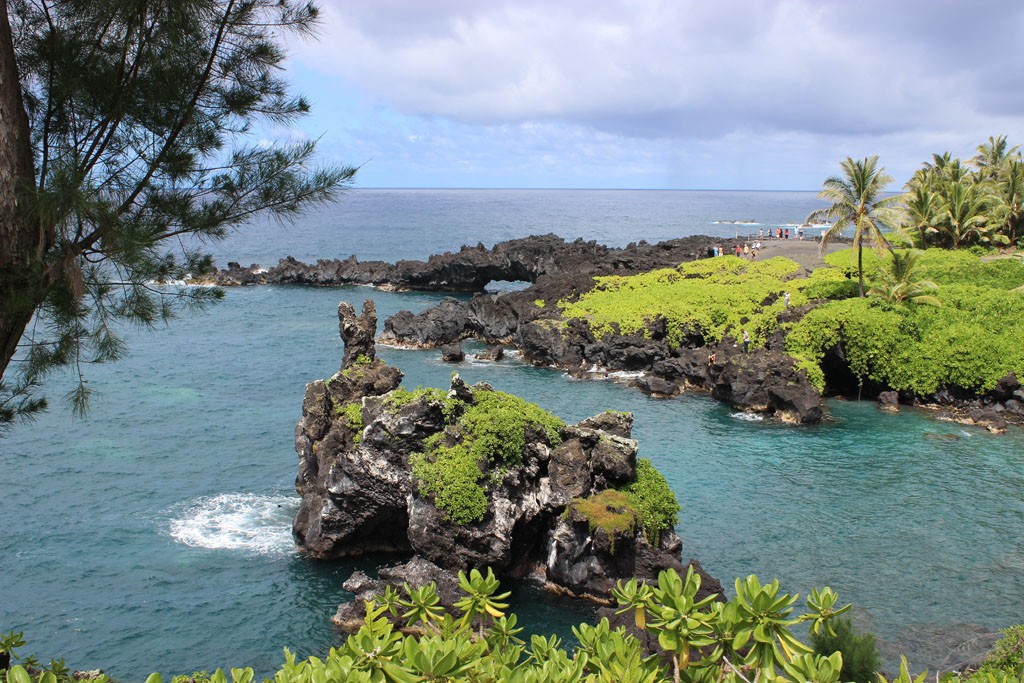Rating: 




In a nutshell: Spectacular views of rugged shoreline, sea arches, black sand beach, and more.
Minuses: Swimming is often marginal.
Sound-bite: “Sir, you should probably stand back from that blowhole.” (…wait for it…)
Note: The park now requires reservations for entry and parking, which can be made here.
DETAILS:
Simply stated, Wai’anapanapa State Park is among the very best of the Road to Hana sites. It offers outstanding nearly 360-degree sweeping panoramic views. On land, the hills and valleys of green jungle give way to rugged and dramatic black basalt lava coastline. Out to sea, the deep blue ocean and white cresting waves are dramatically blasted into spray and mist as they pound against the jagged cliffs. This place looks like a living postcard from heaven.
While a fair amount of people stop here, most do the “park, snap photo, see the black sand, leave” thing, so it is rarely crowded, and what looks like full parking, turns over quickly and without much waiting. There are also plenty of friendly visitors at the most convenient overlooks who you can enlist to snap the perfect postcard photo of you and your honey in front of the heavenly backdrops.
Besides the outstanding scenery there are hikes, easy walks, a blowhole, a black sand beach (and several black-boulder beaches), ocean caves, sea arches, islets, cliff diving, fresh water pools, pre-contact archeological remnants, camping, cabins and more. [stops, takes breath…] Whew! With so much packed in one stop, Wai’anapanapa should be a “must see” destination on practically every Road to Hana trip. (It always is on mine…)
The name Wai’anapanapa means “glistening water”, and while it easily could refer to the beautiful ocean vistas that grace this area, the Hawaiian word specifically applies only to fresh water. One scholar of Hawaiian history told me that it refers to a specific spot within a nearby stream where the features of the stream cause sunlight to reflect in such a way that there is an unusual glistening effect. Others believe it refers to the crystal clear waters in the anchialine pools found in the park’s caves. But any way you slice it, there is no shortage of glistening water in Wai’anapanapa!
Black Sand Beach (Pa’iloa Beach)
The Black Sand beach at Wai’anapanapa is the biggest draw for visitors – there is something about black sand that fascinates folks. Most of this beach is actually less like “sand” and more like “small black pebbles”, so this isn’t a beach you’ll want to lay out on. And unless you know the conditions well, surf can often be too strong for casual swimmers and poor swimmers will not be treated kindly. This area is also frequented by jellyfish and Portuguese man o war. That said, even during rough surf, there are always those that consider themselves uniquely qualified – and you’ll likely see one or two of these weekend warriors impressing themselves here.

On calm ocean days, visitors tend to linger on the black sand beach longer and it can get a bit crowded.
There is also a cool little cave here that the ocean laps up into. To find the cave, go to the right side (as you face the ocean) and look for a small hole in the cliff wall. Duck down and go in – soon the ceiling opens up to allow you to stand. You’ll see some holes in the ceiling which allow light through, and the other end of the cave opens into the ocean. If you’re really adventurous, you can climb through one of the further large holes to pop out on the cliff outside.
Cliff Jumping
You also might see some daring folks jumping form one of the the islets that towers in the bay just east of the black sand beach. For those considering participating, the biggest deciding factor here is your swimming ability and the surf – as long as the ocean is calm, I don’t think you’re taking unseen risks (assuming you look well before you leap.) Since the water is clear when the ocean is calm, you can probably see hazards in the water. As the surf gets rougher, you won’t be able to see where it is safe to jump, and risks of “extreme exfoliation” will become proportionally greater as you try and climb out of the ocean on to that giant jagged pumice stone.
What are Anchialine Pools?
An anchialine pool is a land locked body of water with a subterranean connection to the ocean. Typically, water near the surface is fresh water, becoming brackish with depth as salt water intrudes from the ocean connection at sea-level. Depending on the site, it is sometimes possible to access the deeper saline water directly in the anchialine pool or other times by cave diving.
In Hawaii, the pools are home to ‘opae’ula, a native shrimp. They reproduce in the subterranean portion of the pool, only to be seen in rare occasions (see legend below.)
Unbelievably, ‘opae’ula can live for as long as 20 years in captivity, and since they are very easy to care for, they are popular pets sold in pet stores all over Hawaii. Due to their largely subterranean life, it is unknown how long they live in their natural habitat.
Read in factoids
Anchialine Pool Caves
Update: The loop trail to the caves has been closed, and half of the loop is gone, overcome by hau. This was a very special spot, perhaps what the entire park is named for, and I hope they find a way to reopen it. I have left the text below for those who are interested.
If you follow the trail counter-clockwise you will follow stone steps down through a cut-out in an otherwise impenetrable thicket of hau and come to an open cave area. This first pool has somewhat stagnant water that is shallow and not suitable for swimming. Continue along the trail, you’ll go up some steps this time, and you will come to a short trail to the left that leads to the second pool.
The water here is crystal-clear, clean, and spring-fed. It is also relatively cold (though not unbearably so.) Like pulling off the wax for your bikini-line, the best way into a cold pool is the fast and decisive way! There is the perfect jump-off point for such an entry right in front of you. But the highlight here isn’t the swimming or jumping, but the hidden caves just under what appear to be the main caves walls. (Hope you brought your flashlight?!)
The Legend of the Wai’anapanapa Caves
Once upon a time, a Hawaiian princess named Popoalaea fled from her cruel husband, the chief Kakae. She hid on the ledge just inside the underwater entrance to this cave. A faithful serving maid sat across from her fanning the princess with a feather kahili, a symbol of royalty.
Noticing the reflection of the kahili in the water, the chief Kakae discovered Popoalaea’s hiding place and killed her. At certain times of the year, tiny red shrimp appear in the pool, turning the water red. Some say it is a reminder of the blood of the slain princess.
As told on park sign that was once outside the caves
Read in host culture
The water level fluctuates with the ocean tides, so depending on your timing you may have visual hints as to where the caves are. If not, you’ll have to duck your head just below the water as you enter them. Having a flashlight is optimal, because depending on the time of day (earlier is better) the caves get quite dark just beyond the openings. The larger cave is directly across from the jumping platform.
If you brought a flashlight, you’ll be able to see several caves, including the largest, complete with the legendary princess rock seat, and the seat of her maid. Like most everything in Maui, nothing is roped off or protected – so feel free to sit like a princess. (You’ll find Hawaiian Princesses were clearly less fussy about seating than their picky European counterparts!)
Back in the main cave, there is a second, more narrow cave (to the left of the princess cave) that snakes back a bit, terminating in a man-sized opening into another larger cave. I have heard form several sources (and watched a few pass though over the years) that you can go beyond that pool as well, but a less claustrophobic spelunker/diver is going to have to verify that one – or perhaps I’ll get a bit crazier and pass through it one of these days!
Blowhole
The blowhole is a bit further east on the paved path from the overlook for the islet above.
A blowhole is hole in the ground that connects to an underground, partially submerged ocean cave. The cave and opening are shaped in such a way that when the ocean rises or waves crash into it, a jet of water and air is violently forced out through the hole. Some blowholes are regular and very impressive. This blowhole is not a regular, and only delivers sound and small sprays most of the time. But when the surf and tide is right (like when I took this photo sequence) this blowhole can become impressive.

These guys ignored my pleas to move back from the blowhole. Fortunately they weren't on the edge looking in when this hit!
Warning – begin safety lecture: Now, please don’t be one of the idiots in the picture! Stay back a bit – oh, and never put your head directly above or into the hole! Now, to be fair, the guys in the photo were outside of the “dangerously close” zone – all they got was a complete soaking. But the point is, they had no idea what all the fuss was about when I tried explaining they should move- they watched what they thought was a wimpy bubbler of a blowhole bubble up and lightly mist a bunch of times and deduced it was nothing to avoid, shrugging off my warning. Now these warnings may sound silly – but living on the real-end of paradise can look quite different than the visiting end – just be sure to keep your head on your shoulders. End lecture
Hikes
There are two main hikes you can take from Wai’anapanapa. Both are on the King’s Trail.
East toward Hana: This trail starts with the paved walkways, and passes a Hawaiian cemetery and then the blowhole as it proceeds east. You can make this as short as you want, or up to a five-mile hike. After the blowhole you’ll pass through a grove of native hala trees. After about 3/4 of a mile you’ll reach the Ohala Heiau (there is a sign.) Be mindful that it is disrespectful to climb on the heiau or touch offerings that may be found. Many visitors are not aware that it is also considered disrespectful for them to stack stones or create their own offerings.
The King’s Trail
The King’s Trail was a footpath built in pre-contact Hawai’i for the ali’i (royalty) and royal messengers – primarily so that the king could survey his lands. Some historians believe the King’s Trail circumscribed the entire island of Maui, a significant accomplishment for the time.
Believed to have been begun by King Kahekili, it was completed around 1550 by King Pi’ilani – the latter king’s name is memorialized in the two main highway names for South and West Maui. Much of the original trail has disappeared over the hundreds of years, but some fragments remain and have been restored.
Read in host culture
There are also burial mounds (known and unknown) all around this area. Unlike must culturally significant areas of archeological value you may have visited elsewhere, much of the Hawaiian historical remnants on Maui remain unmarked and unprotected. It is important that you do not disturb any rocks in these areas for this reason – especially if they appear in mounds, stacks or other man-made formations.
After the heiau, the trail continues on toward Kainalimu Bay. The trail is deteriorated and hiking quickly shifts form easy to strenuous. This is the point where most choose to turn back.
If you are prepared for a strenuous hike, you can continue on. At points now the trail will become difficult to trace. One of the methods you can employ to find the trail is to look for the tell-tail smooth rocks inlaid into the rough ‘a’a lavarocks. These are remnants of the original King’s Trail, and when you spot them, you know you’re on the right path. As you continue you’ll be rewarded with impressive lava spires that twist up to the sky, and the ocean views continue to be highly dramatic.
As you hike further you will notice the lava has changed from ‘a’a (like piles of propane grill rocks) to pahoehoe (smoother sheets or “sculpted” flows) and the trail becomes indistinguishable. The trick here is to look for the rock piles that have been placed to mark the trail – follow from pile to pile through the pahoehoe. This area has many lava tubes and caves – you should be somewhat careful when walking around as some areas may be just a thin, crumbling sheet above a cave.
After the lava, at around 2 1/2 miles you’ll pass the “Waianapanapa 3 miles” sign (yeah, I know…) and you’ll come to a green jungle gulch. Follow the trail into the gulch, and down to Kainalimu Bay. You’ll usually have the bay practically all to yourself – so enjoy!
Unless you don’t care about getting your car and the practicality of continuing on, this is probably the turn-back point. Even if you’d like to continue your coastal King’s Trail trek, you should seriously consider heading back on the trail to Wai’anapanapa and driving your car somewhere closer, like Hana Bay.
North toward Hana Airport: this section of the King’s Trail is called Kipapa O Kihapi’ilani Trail. The trail is somewhat strenuous and 2.75 miles round-trip. Noted sites on this portion of trail: Kapukaulua burial site, two black rock coves, a large lava tube, ruins, and Pukaulua Point which is the site of a heiau and burial mounds. The original trail passed through the area that is now the Hana Airport, so, as you can imagine, nowadays the trail ends abruptly at the airport security fence.
To begin on this trail, go to the North (far) end of the black sand beach, look for the trail, and continue to the black-stone cove just adjacent. At this point where to continue on the trail will become apparent. A bit further the trail will fork, the right fork soon takes you to the Kapukaulua burial site. Backtracking to take the left fork continues the trail. The trail continues on to a second cove. The cove itself is part of the trail, and the trail picks up toward the other side.
If Driving The Road Is Going To Stop You
For some people a day of planned around driving a windy narrow jungle road doesn’t sound like fun. If that’s you, take a peek at my article about Valley Isle Excursions – a great local company that offers reasonably priced small guided van tours packed with so much information and aloha. Don’t skip visiting this treasure while you’re here!
Key Info:
Mile Marker: #32 (Hana Hwy aka Hwy 360)
GPS Coordinates: 20.788616,-156.003687
Facilities: camping, cabins, picnic tables, bbq’s, bathrooms, showers.
State of Hawaii DNLR page where you can book the cabins.
Get directions
View Waianapanapa State Park in a larger map
 MauiGuidebook.com
MauiGuidebook.com 



Craig Harris says:
?are the showers hot, coin operated or cold beach showers?
Christopher G says:
Reservations needed so plan ahead or upon arrival they will turn you around.
Katie says:
The hike to Hana is incredibly beautiful along the cliffs. Be aware that there is no Uber/Lyft of taxi service in Hana so you will be walking back along the Hana Highway to get to your car. The road is safer than it sounds and a gorgeous jungle view.
Eleanor says:
Can’t remember who the woman was that was buried at the top of the cliff overlooking the beach and water and can’t find any info about her
Kris says:
Another great post for the guidebook, especially covering such a big place like Wai’anapanapa State Park.
We’ve been there twice, and it wasn’t until the second time that I went down into the lava cave right next to the beach. I was so stoked, I ran out back up to where my wife was shooting video from the lookout point above and “borrowed” the camera from her.
Took some nice video from inside, and the listening to the waves crashing nearby and the water making a sizzling sound as it retreats from the rocks always brings me back.
Mike says:
I think you mean MOST, not
MUST. And thanks for the info!
Unlike must culturally significant areas of archeological value you may have visited elsewhere, much of the Hawaiian historical remnants on Maui remain unmarked and unprotected. It is important that you do not disturb any rocks in these areas for this reason – especially if they appear in mounds, stacks or other man-made formations.